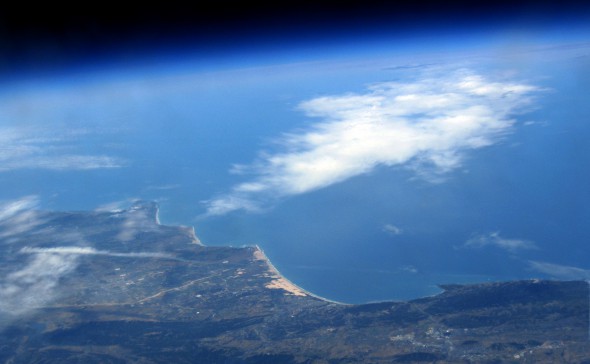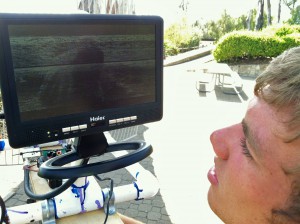Anacapa Club to Launch its Second Near Space Probe
High school students combine homebrew electronics and wireless communications to send back images and data from the edge of space

AAHAB-1 reached an altitude of 91,122 feet overlooking the Central Coast, San Luis Obispo Bay and the Pismo Dunes.
May 1, 2012 — Santa Barbara, Calif.
The Anacapa Near Space Exploration Club (ANSEC) at Anacapa School will reach for the stars once again with its second near space probe, Anacapa Amateur High-Altitude Balloon 2 (AAHAB-2). Last year, the high school club sent a payload of sensors and a camera to 91,122 feet above California’s Central Coast and recovered it successfully. This year, the team has set even more ambitious goals including a live video downlink, high-definition recording, radiation sensors and live radio telemetry.
AAHAB-2 was designed and built entirely by Anacapa students Grayson Baggiolini, Julio Bernal, Alex Carlson, Christian Eckert and Genevieve Hatfield under the supervision of their faculty advisor Levi Maaia. The team has been working on the project since the beginning of the school year. If all goes according to plan, the students will launch the probe in the early morning hours of Saturday, May 5th.
“We are hoping the winds will cooperate and we will be able to launch from West Beach in Santa Barbara,” said Carlson, an 18-year-old senior and the mission’s flight director. “However, if the weather models call for a southerly flow, we may have to use an alternate launch site near Paso Robles.”
Carlson, along with Hatfield, a 15-year-old sophomore, studied for and passed the Federal Communications Commission exam for their amateur radio licenses. This certification allows the group access to special wireless spectrum allocations reserved for radio experimentation and scientific purposes. By building off ANSEC’s inaugural AAHAB-1 probe, the AAHAB-2 team is hoping to downlink live video and atmospheric data from the probe throughout its two- to three-hour flight through the stratosphere and into the freezing, dark daytime skies of near space.
Despite the diversity of systems and the complexity of the electronics on board, the budget for the entire project was less than $2,000, a figure made possible by the students’ efficient design and technical ingenuity. For 11th graders Bernal, 17 and Eckert,16, this is the second high-altitude probe project they have been part of at Anacapa.
“Last year, I mainly worked on the capsule design,” explained Bernal. “This year, I really wanted to learn about the electronics, so I built an electronic Geiger counter to measure and record radiation levels throughout the flight.”
During Saturday’s flight, the students, as well as amateur balloonists and radio enthusiasts around the country, will track the craft’s progress using data received through the Automatic Position Reporting System (APRS), a worldwide digital wireless system which can receive digital radio signals in places where cellular phones and traditional Wi-Fi cannot.
More information, including links to live flight tracking on Google Maps and the group’s Facebook page, can be found online at www.anacapaschool.org/ansec.
Anacapa School is an independent, co-educational, WASC–accredited, college preparatory day school for students in grades 7-12. Founded in 1981 by Headmaster Gordon Sichi, Anacapa enjoys the best student-teacher ratio of any school, public or private, in Santa Barbara at its historic campus located in the heart of the Santa Barbara civic center.
Media Contact:
Levi C. Maaia
805-604-5384 • levi@anacapaschool.org
www.anacapaschool.org • www.facebook.com/anacapaschool

